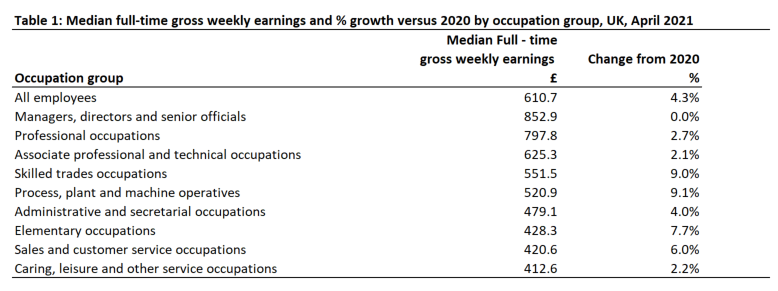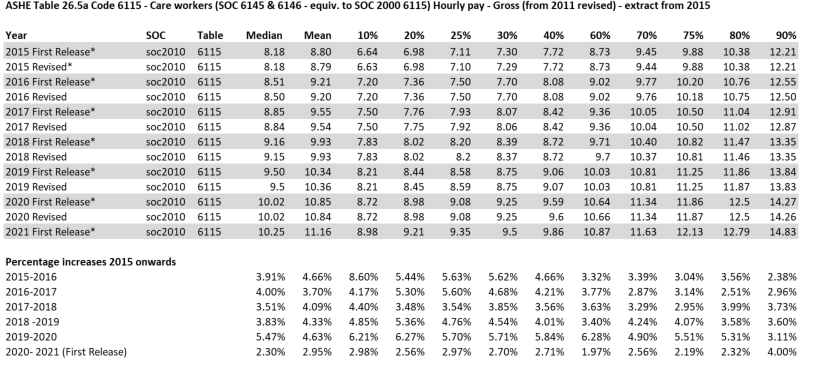The big picture
A summary of the annual increases included in the ONS release is reproduced below for ease of reference, based on Figure 7 of the 2021 ASHE release (and ASHE Table 2.1a). The average increase for all full-time employees is 4.3%. The corresponding increases for inflation are CPI 1.5% and RPI 2.9% for the 12 months ended April 2021.

Last year, the increase for all full-time employees was 0.1%, so this year's increase is significantly higher. However, any comparison with 2020 should be treated with caution; the data for April 2020 was affected by the COVID-19 pandemic, both in terms of wages and hours worked and issues with data collection. Table 1 of the 2021 ASHE Update (which can be found in section 4) provides details of the percentage of jobs by type furloughed under the Coronavirus Job Retention Scheme, with reduced pay, summarised for all employees, geographically and by occupation. The proportion of total employees furloughed fell to 6% in April 2021, compared with 12% in 2020, which will explain some of the growth in 2021. The table shows that in April 2021, younger workers and those working in accommodation and food services, as well as in arts and entertainment, were more likely to be furloughed.
The links to the tables are as follows:
- The individual Tables numbered 1 to 28 can be found here, although they are not listed in numerical order. Selecting a particular table will take you to a page with links to all the figures published for that table from 1997 (or such later date as the table started) to the 2021 provisional figures. The figures for each year are opened as a zip file which gives access to all the sub-tables (for example, 11.1a, 11.1b to 11.12). Clicking on the required sub-table will open the corresponding excel file. The tabs along the bottom of the spreadsheet further split the figures between All, Male, Female, Full-time and Part-time.
- Alternatively, the Statistical Bulletin includes an overview of the changes from the 2020 to 2021 figures. To access the results tables, click on the green button "View all data used in this statistical bulletin" to bring up the same Tables 1 to 28 as accessed from the above link (although again not in numerical order).
Care costs and periodical payments
The ASHE table relevant to indexing the majority of periodical payment orders (most of which relate to care costs) is Table 26.5a SOC 6145 & 6146 (previously SOC 6115).
The Table 26 dataset can be found here. The figures are shown below together with the percentage increase over the final 2020 figures:

Care costs showed a 2.3% increase in the median hourly rate in the year to April 2021 (compared with 5.47% in the year to April 2020). This reflects that the rise in the National Living Wage was only 2.18% in April 2021, compared with higher increases of 4.85% in April 2019, and 6.22% in April 2020. In the same period, CPI was 1.5% and RPI was 2.9%. The figures shown in Table 26.5a include employees who have been furloughed under CJRS. It is worth noting that the higher increase across all professions (of 4.3% on gross weekly earnings) was impacted by significant increases for Skilled trade occupations and Process, plant and machine operatives (being 9.0% and 9.1% respectively).
The long term impact of Brexit and COVID-19 on earnings growth is still uncertain. From 11 November 2021, all care home workers must be vaccinated (click here for current government guidance). This (alongside restrictions on the free movement of workers from the EU) may further reduce the number of available workers. Employers would need to make it financially attractive for their employees to stay, as worker shortages could make changing employers (or even changing professions) easier.
These increases are in line with the overall 2.2% increase in Caring, leisure and other service occupations (Table 1 above). With the majority of periodical payments linked to the 80th percentile, many annual payments due in December 2021 will increase by only 2.32%, compared to 5.31% in 2020 (in line with CPI and RPI):

DWF PPO administration
Our Forensic team offers an Annual Update service for periodical payment orders to calculate the next payment due and can also review earlier payment calculations if there are queries over the amounts paid.
For further information, please contact Helen Walters or Lauren Highton.

















